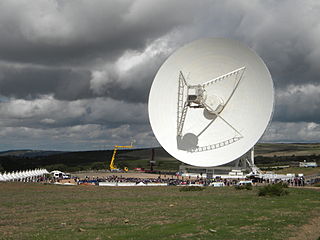
The Large Binocular Telescope (LBT) is an optical telescope for astronomy located on 10,700-foot (3,300 m) Mount Graham, in the Pinaleno Mountains of southeastern Arizona, United States. It is a part of the Mount Graham International Observatory.

The Galileo National Telescope, is a 3.58-meter Italian telescope, located at the Roque de los Muchachos Observatory on the island of La Palma in the Canary Islands, Spain. The TNG is operated by the "Fundación Galileo Galilei, Fundación Canaria", a non-profit institution, on behalf of the Italian National Institute of Astrophysics (INAF). The telescope saw first light in 1998 and is named after the Italian Renaissance astronomer Galileo Galilei.
The Joint Institute for Very Long Baseline Interferometry European Research Infrastructure Consortium (JIVE) was established by a decision of the European Commission in December 2014, and assumed the activities and responsibilities of the JIVE foundation, which was established in December 1993. JIVE's mandate is to support the operations and users of the European VLBI Network (EVN), in the widest sense.
The Cagliari Observatory is an astronomical observatory owned and operated by Italy's Istituto Nazionale di Astrofisica. It is located 20 km away from Cagliari in Sardinia. It was founded in 1899 to study the Earth's rotation.

The Astronomical Observatory of Capodimonte is the Neapolitan department of Istituto Nazionale di Astrofisica, the most important Italian institution promoting, developing and conducting scientific research in the fields of astronomy, astrophysics, and space science.

The Observatory of Turin is an astronomical observatory owned and operated by Italy's National Institute for Astrophysics. It is located on the top of a hill in the town of Pino Torinese near Turin, in the north Italian Piedmont region. The observatory was founded in 1759. At Pino Torinese, several asteroid discoveries were made by Italian astronomer Luigi Volta in the late 1920s and early 1930s. The asteroid 2694 Pino Torinese was named after the observatory's location.

The Brera Observatory is an astronomical observatory in the Brera district of Milan, Italy. It was built in the historic Palazzo Brera in 1764 by the Jesuit astronomer Roger Boscovich. Following the suppression of the Jesuits by Clement XIV on 21 July 1773, the palace and the observatory passed to the then rulers of northern Italy, the Austrian Habsburg dynasty.

Astronomical Observatory of Trieste is an astronomical center of studies located in the city of Trieste in northern Italy.
The Istituto di Radioastronomia di Bologna is one of research facilities of the Italian Istituto Nazionale di Astrofisica. Staff conduct research in astronomy, physics, engineering and information science. It was previously part of the Consiglio Nazionale delle Ricerche.

The Astronomical Observatory of Rome is one of twelve Astronomical Observatories in Italy. The main site of the Observatory is Monte Porzio Catone. Part of the Istituto Nazionale di Astrofisica since 2002.

The Medicina Radio Observatory is an astronomical observatory located 30 km from Bologna, Italy. It is operated by the Institute for Radio Astronomy of the National Institute for Astrophysics (INAF) of the government of Italy.

The Planetary Fourier Spectrometer (PFS) is an infrared spectrometer built by the Istituto Nazionale di Astrofisica along with the Istituto di Fisica dello spazio Interplanetario and the Consiglio Nazionale delle Ricerche. The instrument is currently used by the European Space Agency on both the Mars Express Mission and the Venus Express Mission. It consists of four units which together weigh around 31.4 kg, including a pointing device, a power supply, a control unit, and an interferometer with electronics.

The Sardinia Radio Telescope (SRT) is 64-metre fully steerable radio telescope near San Basilio, Province of Cagliari, Sardinia, Italy. Completed in 2011, it is a collaboration between the Istituto di Radioastronomia di Bologna, the Cagliari Observatory (Cagliari) and the Arcetri Astrophysical Observatory (Florence).
Germano D'Abramo is an Italian mathematician, physicist and discoverer of minor planets.

The Rapid Eye Mount telescope (REM) is a fully automatic, 60 cm aperture telescope located at ESO's La Silla Observatory at 2,400 metres altitude on the edge of the Atacama Desert in Chile. The telescope's aim is to catch the afterglows of gamma-ray bursts (GRBs). REM is triggered by a signal from a high-energy satellite such as Swift and rapidly points to the detected location in the sky. It is operated for the Italian National Institute for Astrophysics since 2002.
HARPS-N, the High Accuracy Radial velocity Planet Searcher for the Northern hemisphere is a high-precision radial-velocity spectrograph, installed at the Italian Telescopio Nazionale Galileo, a 3.58-metre telescope located at the Roque de los Muchachos Observatory on the island of La Palma, Canary Islands, Spain.
Giampaolo Vettolani is an Italian astrophysicist, scientific director of the National Institute for Astrophysics in Rome (INAF) since 2012.

Guido Horn d'Arturo was an Italian astronomer born in Trieste, then part of the Austrian Empire. He obtained Italian citizenship after serving as a volunteer in the Italian army during the First World War. To avoid being persecuted as an irredentist by the Austrian authorities, he officially added to his surname Horn that of "d'Arturo" which he used in the war.

Nicolò D'Amico (1953-2020), also known as Nichi D’Amico, was an astronomer and President of Istituto Nazionale di Astrofisica.

Alessandro De Angelis is an Italian and Argentine physicist and astrophysicist. A Professor of Experimental Physics at the University of Padova and Professor Catedratico of Astroparticle Physics at IST Lisboa, he is mostly known for his role in the proposal, construction and data analysis of new telescopes for gamma-ray astrophysics. He is a member of Istituto nazionale di fisica nucleare (INFN), Istituto nazionale di astrofisica (INAF), Italian Physical Society (SIF), International Astronomical Union (IAU), Gruppo2003.
















